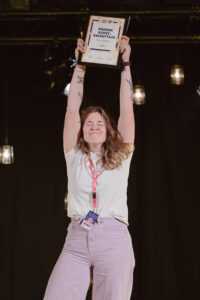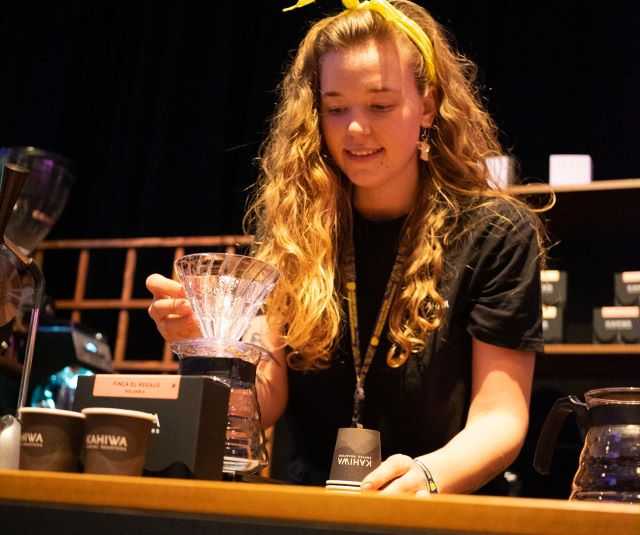MILAN – Kimia Bergeson is a well-known figure in the international community of coffeelovers: from Finland, behind the counter of Kahiwa Coffee Roasters, she is committed to making culture around the drink, even in a country like hers where it is almost taken for granted that, of coffee, they know every secret (being the nation with the largest number of consumers). Let’s see what really happens with those who deal with customers every day.
Kimia Bergeson, Finland is the first country in terms of coffee consumption: but how do you drink it and where?
“My work days (at Kahiwa Coffee Roasters) are almost wholly espresso based drinks (espressos, flat whites, etc.) since I spend most of my cafe days behind our Slayer espresso machine pulling shots.
On my days off though, I love making AeroPresses and using my origami brewer. I do a lot of coffee swaps with coffee friends around the world so I drink something different every day.
I would say a typical Finn drinks just filter coffee, at home, as fuel in the morning to get through the rest of the day, and wants it ‘as dark as possible’. Most likely, they’ve bought their coffee from the grocery store, but slowly but surely people are learning to ‘shop small roastery’.”
In Italy, coffee is a social ritual, which often has a bonding role between people: how is this moment interpreted in Finland? Is it a break that invites sharing?
“For many of the older Finns, coffee is just the gas in the tank. But I really feel like the younger generation has learned to enjoy coffee and the relaxing, social ritual behind it. We go to coffee shops to do work, a lot of younger Finns are starting to meet for coffees instead of beers, and during the dark winter months (of which we have many) people will take walks that start or end in their favourite coffee shop.
Fun fact: it’s actually a part of Finnish law as well that employees receive 5 minute coffee breaks throughout their work days and some offices opt to have that break all together.”
Are specialty coffees in Finland widespread in coffee shops, supermarkets and even home consumption?
“Through out Helsinki, for sure. We have 20+ cafes in Helsinki alone that I would consider ‘specialty’. Most of them supplying Finnish roasteries, but a few here and there are doing guest roasting spots.
Then the further you go from the capital, we’ll maybe have 1-2 specialty coffee shops per big city, and those shops are generally attached to the roastery where their coffee comes from.
Many of these roasteries coffees can be found in grocery stores too, which has been a nice way to introduce normal consumers to new roasteries and coffee companies. But I think most home consumers do use the roasteries own web stores.”
Kimia Bergeson, how does Finland fit into the green coffee supply routes? Which ports do the sacks arrive at and from which main origins do you source?
“I don’t deal with green coffee buying, to be honest. But from what I’ve understood from roasters I’ve worked with, most of our coffee comes though Helsinki and the most common origins I’ve seen from Finnish roasteries are probably Brazil or Guatemala. Ethiopian coffees also pop in here and there but I’ve noticed they’re always those ‘top shelf, masterpiece’ roasts!”.
How much espresso is drunk?
How much can an espresso bar and filter cost?
“An espresso general costs 2.5-3€ and I would say a batch brew around the same. Hand brews however tend to be closer to 5€.”
When entering a Finn’s home, what do you find? For us in Italy definitely a moka coffee maker and probably a capsule machine: what equipment do you use most there?
“Moccamaster! Almost every single coffee-drinking home I’ve been to, has a Moccamaster, or a similar type filter coffee machine. Capsules haven’t quite hit Finnish markets yet, and honestly I don’t really think will as Finns are generally quite conscious of plastic waste. Mokkapots however are also quite common too. With students especially, they’re really popular as they’re an affordable way to get strong, hot coffee quick.”
You are the best coffee influencer 2023: can you tell us about this title?

Kimia Bergeson :”Yeah that was a pretty cool title to win! I have been working in coffee for more than 8 years and have a background in event organising so I have been lucky enough to organise events, such as Helsinki Coffee Week, Moccamaster championships, and the Finnish AeroPress Championships.
All of these events are done with the intention of connecting the Finnish Coffee community, improving our industry and our crafts, and introducing specialty coffee to people outside of our industry.
I’ve also been acting as a founding member of The Happy Coffee Network, an online global network for coffee people who want to learn, connect, and bond over this industry. So I would say this win was more because of my impact on the Finnish coffee community, rather than my social media influence, which this title could be confused for.”
In what direction is coffee culture moving in Finland? What are the new trends?
“Our coffee culture as a whole is moving slowly but surely towards the direction of sustainability and awareness, as many consumers are starting to value coffee and be interested in where its coming from and how that impacts the coffees flavours.
We are also empowering customers to step outside of their comfort zone and drink more than just that dark roasted, burnt morning cup that many of them are used to.
But if you wanted to know what trends are happening inside the local community, I could tell you that coffee competitions are making a comeback and soon we will have Finns on their way to represent in global coffee competitions. Myself and some other excited coffee pros are reviving the Finnish SCA and though we have our work cut out for us, we are planning on hosting the first set of competitions in fall 2024.”










